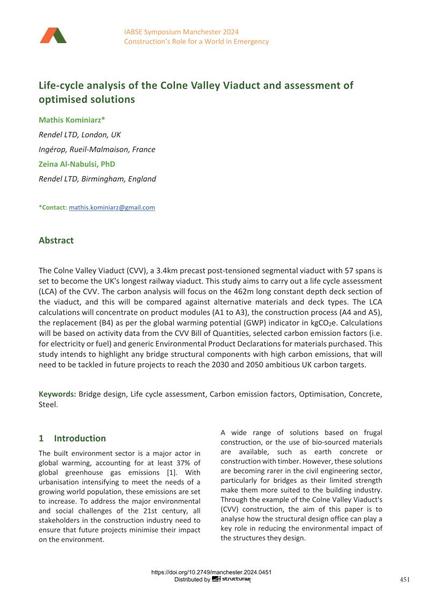Life-cycle analysis of the Colne Valley Viaduct and assessment of optimised solutions

|
|
|||||||||||
Détails bibliographiques
| Auteur(s): |
Mathis Kominiarz
(Rendel LTD, London, UK; Ingérop, Rueil-Malmaison, France)
Zeina Al-Nabulsi (Rendel LTD, Birmingham, England) |
||||
|---|---|---|---|---|---|
| Médium: | papier de conférence | ||||
| Langue(s): | anglais | ||||
| Conférence: | IABSE Symposium: Construction’s Role for a World in Emergency, Manchester, United Kingdom, 10-14 April 2024 | ||||
| Publié dans: | IABSE Symposium Manchester 2024 | ||||
|
|||||
| Page(s): | 451-459 | ||||
| Nombre total de pages (du PDF): | 9 | ||||
| DOI: | 10.2749/manchester.2024.0451 | ||||
| Abstrait: |
The Colne Valley Viaduct (CVV), a 3.4km precast post-tensioned segmental viaduct with 57 spans is set to become the UK's longest railway viaduct. This study aims to carry out a life cycle assessment (LCA) of the CVV. The carbon analysis will focus on the 462m long constant depth deck section of the viaduct, and this will be compared against alternative materials and deck types. The LCA calculations will concentrate on product modules (A1 to A3), the construction process (A4 and A5), the replacement (B4) as per the global warming potential (GWP) indicator in kgCO2e. Calculations will be based on activity data from the CVV Bill of Quantities, selected carbon emission factors (i.e. for electricity or fuel) and generic Environmental Product Declarations for materials purchased. This study intends to highlight any bridge structural components with high carbon emissions, that will need to be tackled in future projects to reach the 2030 and 2050 ambitious UK carbon targets. |
||||
| Mots-clé: |
acier béton
|
||||
